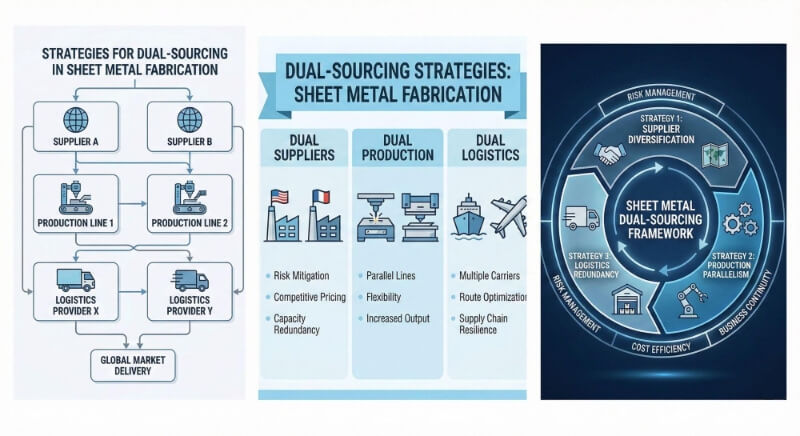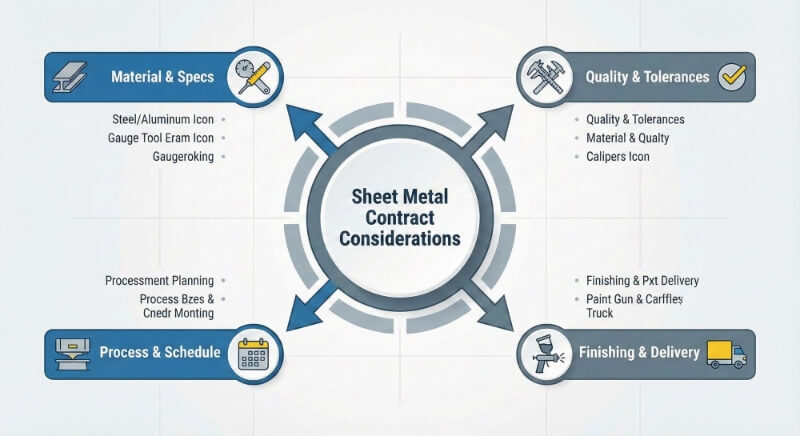Cuando las piezas metálicas empiezan a oxidarse, su rendimiento disminuye. Muchas fábricas intentan ralentizarlo utilizando imprimaciones o revestimientos. Sin embargo, no todos estos métodos funcionan bien ni duran mucho. El revestimiento de fosfato negro ofrece una solución mejor al proteger el metal desde la superficie. Forma una capa resistente que aumenta la resistencia y reduce el desgaste.
El fosfatado negro tiene varias ventajas. El proceso es rápido y fácil de aplicar, y funciona en muchos tipos de piezas de acero. A continuación, veremos cómo funciona el recubrimiento de fosfato negro, sus características principales y dónde se utiliza con más frecuencia.
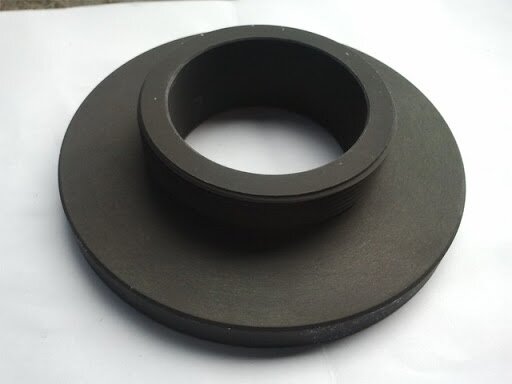
¿Qué es el recubrimiento de fosfato negro?
El revestimiento de fosfato negro es un proceso de conversión química. Aplica al acero una fina capa de fosfato cristalino de color gris oscuro o negro. Esto ocurre cuando las piezas se sumergen en una mezcla caliente de ácido fosfórico y otros productos químicos añadidos. El revestimiento se adhiere al metal y crea una superficie protectora de tacto ligeramente rugoso.
Este revestimiento ayuda a reducir la fricción, ofrece una ligera protección contra el óxido y mejora la permanencia del aceite o la pintura en la superficie. No detiene por completo la oxidación por sí solo, pero funciona bien como capa base para otros acabados protectores.
El revestimiento es fino: suele tener un grosor de entre 0,0001 y 0,0003 pulgadas. No afecta demasiado al tamaño de la pieza, por lo que es ideal para piezas que requieren ajustes estrechos o medidas precisas.
La ciencia del recubrimiento de fosfato
El revestimiento de fosfato funciona mediante una reacción química controlada entre el acero y una solución especial de fosfato. Esta reacción forma una capa cristalina que se adhiere a la superficie metálica. El resultado es un acabado fuerte y protector que mejora el rendimiento de la pieza.
Composición química del fosfato negro
Los revestimientos de fosfato negro están hechos principalmente de fosfato de hierro (FePO₄). A menudo incluyen elementos adicionales como manganeso o zinc. La solución de revestimiento contiene ácido fosfórico, agua y sales metálicas. El ácido reacciona con la superficie cuando se sumerge una pieza de acero en esta mezcla calentada.
Esta reacción disuelve ligeramente el metal. Al mismo tiempo, se forman cristales de fosfato que se adhieren a la superficie. Estos cristales de color gris oscuro o negro tienen una textura uniforme y ligeramente rugosa. Esta textura ayuda a que los aceites y las pinturas se adhieran mejor.
El revestimiento no sólo se asienta sobre la pieza, sino que se fusiona con la superficie. Esta unión confiere a la capa su resistencia y ayuda a la pieza a soportar mejor la tensión y la fricción.
El papel del manganeso frente al zinc en los revestimientos
El manganeso y el zinc son aditivos comunes en los recubrimientos de fosfato. Cada uno de ellos aporta diferentes beneficios, en función de las necesidades de la pieza.
El fosfato de manganeso (MnPO₄) crea un revestimiento más grueso y resistente. Es ideal para piezas móviles como engranajes o bujes. Los cristales más grandes retienen más aceite, lo que favorece la lubricación y reduce el desgaste.
Fosfato de zinc(Zn₃(PO₄)₂) forma una capa más suave y fina. Es mejor para prevenir el óxido y ayudar a que la pintura se adhiera. Muchas piezas de coches se recubren con fosfato de cinc antes de pintarlas.
El fosfato negro suele contener más cinc, lo que lo hace mejor para uso general, especialmente cuando la atención se centra en la protección contra el óxido y la apariencia en lugar del desgaste intenso. La elección entre manganeso y zinc depende de cómo se vaya a utilizar la pieza en el mundo real.
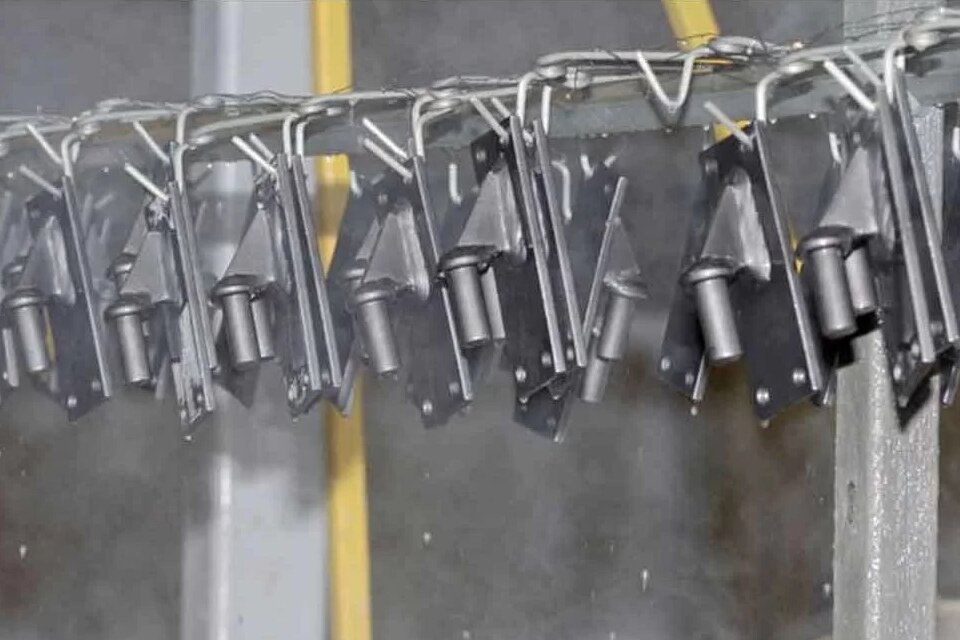
Cómo funciona el proceso de recubrimiento con fosfato negro?
El proceso de recubrimiento con fosfato negro implica varios pasos sencillos. Cada uno de ellos afecta al aspecto final de la superficie, a su duración y a su rendimiento en el uso real.
Preparación de la superficie
El primer paso es limpiar la pieza metálica. Hay que eliminar toda la grasa, aceite, suciedad y óxido. Si la superficie no está limpia, el revestimiento no se adherirá bien y puede que no dure.
La mayoría de las piezas se someten a un desengrasante alcalino para eliminar los aceites de corte o manipulación. Si hay óxido o un revestimiento antiguo, puede utilizarse decapado ácido para eliminarlo. Tras la limpieza, la pieza se aclara con agua para eliminar los restos de productos químicos.
Química y condiciones del baño de fosfatado
A continuación, la pieza se introduce en un baño de fosfato caliente. Este baño contiene ácido fosfórico, sales de zinc o manganeso y otros aditivos. La temperatura suele mantenerse entre 160°F y 200°F.
En cuanto la pieza entra en contacto con la solución, comienza la reacción. La superficie metálica se disuelve ligeramente y comienzan a formarse y adherirse cristales de fosfato.
El tiempo de permanencia en el baño depende del revestimiento necesario. La mayoría de las piezas permanecen en la solución entre 5 y 15 minutos, pero un tiempo mayor proporciona un revestimiento más grueso.
Aclarado, neutralización y secado
Una vez fosfatada, la pieza se enjuaga con agua limpia. Esto detiene la reacción y elimina cualquier material suelto o sobrante. Algunos procesos incluyen un aclarado neutralizador para eliminar los restos de ácido y evitar manchas o acumulaciones de polvo.
Tras el aclarado, se seca la pieza. El secado puede realizarse con sopladores de aire, calefacción o ambos. La pieza debe estar completamente seca antes de pasar al siguiente paso o guardarla.
Postratamiento opcional
Los revestimientos de fosfato negro son ligeramente porosos, lo que significa que dejan pasar algo de humedad o aire. A menudo se añade un tratamiento final para aumentar la protección.
Este tratamiento posterior suele incluir aceite, cera o selladores. Estos rellenan los pequeños agujeros de la superficie e impiden que el agua o el aire lleguen al metal. El aceite es el más común. Aporta un acabado suave, reduce la fricción y da a la pieza un aspecto negro más profundo.
Este último paso consiste en sumergir o rociar la pieza una vez seca. Aunque casi no añade grosor, hace que el revestimiento dure más y funcione mejor.
Características principales del revestimiento de fosfato negro
El revestimiento de fosfato negro confiere a las piezas de acero una mezcla única de aspecto y funcionalidad. A continuación se indican los rasgos más valorados que lo hacen popular en muchas industrias.
Aspecto y textura de la superficie
El revestimiento es de color gris oscuro a negro. Crea un acabado mate, no reflectante. Es ideal para piezas poco reflectantes, como herramientas o componentes de armas de fuego.
La textura es ligeramente rugosa debido a los cristales de fosfato. Esto ayuda a la superficie a retener el aceite o la pintura. El acabado es uniforme y limpio cuando el proceso se realiza correctamente.
Propiedades de resistencia a la corrosión
Por sí solo, el fosfato negro ofrece una ligera protección contra la corrosión. Ralentiza la oxidación, pero no la detiene por completo. El revestimiento impide que parte de la humedad y el aire lleguen al acero desnudo.
Cuando se combina con aceite o cera, su resistencia mejora enormemente. La capa superior rellena los poros y mantiene fuera la humedad, por lo que es bueno para uso en interiores o piezas que se almacenarán antes de su uso.
Mejora de la adherencia de la pintura
La superficie rugosa y porosa que deja el fosfatado ayuda a que la pintura se adhiera mejor. La pintura se adhiere a la superficie en lugar de asentarse sobre ella. Esto evita que se descascarille con el tiempo.
Por eso el fosfato negro se utiliza a menudo como capa base antes de pintar. Mejora tanto el aspecto como la vida útil de la pieza pintada.
Lubricidad y resistencia al desgaste
El fosfato negro reduce la fricción entre las piezas deslizantes. El recubrimiento retiene bien el aceite, lo que ayuda a que las piezas se muevan con suavidad durante el uso.
Esto lo hace útil para sujetadoresengranajes y piezas sometidas a poco desgaste. No sustituye a los revestimientos duros ni enchapado pero funciona bien cuando se necesita una protección ligera y de bajo coste.
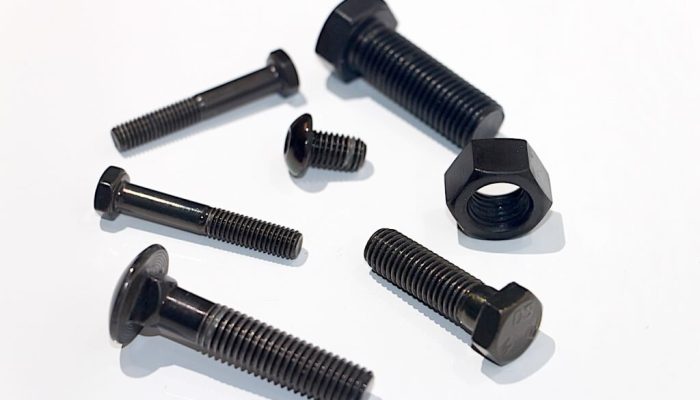
Materiales adecuados para el recubrimiento de fosfato negro
El revestimiento de fosfato negro funciona mejor en metales ferrosos (materiales a base de hierro). Esto es lo que debe saber sobre la compatibilidad de materiales:
Aceros de bajo y medio carbono
El fosfato negro funciona mejor en aceros de bajo y medio carbono, que tienen la química superficial adecuada para reaccionar con la solución de fosfato.
Este revestimiento se utiliza a menudo en elementos de fijación de acero al carbono, soportesy casquillos. La capa se forma uniformemente y se adhiere bien, mejorando la lubricidad y la resistencia a la corrosión.
Hierro fundido y aceros aleados
El hierro fundido también puede fosfatarse. El revestimiento puede no parecer tan liso como en el acero al carbono, pero sigue formando una capa protectora. La superficie porosa del hierro fundido ayuda a retener el aceite tras el revestimiento, lo que aumenta la resistencia a la oxidación.
Algunos aceros aleados también responden bien, pero depende del contenido de aleación. Los aceros con altas cantidades de cromo o níquel pueden no reaccionar con tanta fuerza, lo que da lugar a un recubrimiento débil o desigual.
Metales inadecuados y por qué fallan
El recubrimiento de fosfato negro no funcionará en aluminio, acero inoxidable, cobre o latón. Estos metales carecen de la química superficial necesaria para que se formen los cristales de fosfato.
El acero inoxidable tiene una capa pasiva de cromo que bloquea la reacción. El cobre y el latón no reaccionan con el ácido de la misma manera que el hierro.
Si estos metales se introducen en un baño de fosfato, pueden decolorarse, picarse o quedar sin recubrimiento. Otros tratamientos superficialescomo anodizado, pasivacióno chapado, son mejores opciones para ellos.
Fosfato negro frente a óxido negro
El fosfato negro y el óxido negro oscurecen las superficies de acero y mejoran su rendimiento. Sin embargo, se fabrican mediante procesos diferentes y sirven para fines ligeramente distintos.
El fosfato negro es un revestimiento de conversión química. Forma una capa de cristales de fosfato en la superficie del acero. Este revestimiento es ligeramente poroso y retiene bien el aceite. Ayuda a reducir la fricción, ralentiza la corrosión y mejora la adherencia de la pintura. Añade algo de grosor: entre 0,0001 y 0,0003 pulgadas.
Óxido negro también es un tratamiento químico, pero convierte la capa superior del acero en magnetita (Fe₃O₄). Esta capa es mucho más fina, de unas 0,00002 pulgadas. El óxido negro da un acabado más oscuro y brillante. Suele utilizarse en herramientas, piezas de armas y componentes de precisión en los que las tolerancias son críticas.
Diferencias clave:
- Espesor: El fosfato es más grueso. El óxido negro es muy fino.
- Tacto superficial: El fosfato tiene una textura mate y ligeramente rugosa. El óxido negro es liso y brillante.
- Póngase: El fosfato mejora más la lubricidad. El óxido negro tiene menor resistencia al desgaste a menos que se trate posteriormente con aceite.
- Protección contra la corrosión: Ambos necesitan aceite o cera para resistir bien el óxido. El fosfato tiende a retener mejor el aceite.
- Color: El fosfato es de color gris oscuro a negro. El óxido negro es negro intenso.
La elección correcta depende de la aplicación. Utilice fosfato negro para piezas deslizantes, pernos y piezas que necesiten aceite. Elija óxido negro cuando el detalle de la superficie o el ajuste estrecho sean más importantes.
Ventajas del revestimiento de fosfato negro
El revestimiento de fosfato negro ofrece ventajas prácticas para piezas que necesitan protección, un mejor funcionamiento o un aspecto específico. Añade valor sin costes elevados ni procesos complejos.
Resistencia a la corrosión mejorada
El revestimiento actúa como barrera entre el metal y el aire. Por sí solo, frena la oxidación. Si se combina con aceite o sellador, la protección mejora mucho.
Mantiene la humedad fuera y ayuda a proteger las piezas durante el almacenamiento, el transporte o el uso inicial. Añadir resistencia al óxido sin necesidad de chapado o pintura pesada es sencillo.
Lubricidad y resistencia al desgaste mejoradas
El fosfato negro retiene muy bien el aceite, lo que hace que las piezas sean más resistentes al gripado y la fricción. Los tornillos se instalan más fácilmente y las piezas deslizantes se mueven con más suavidad.
Reduce el desgaste metal-metal en condiciones de baja carga. Aunque no sustituye a los revestimientos duros, funciona bien como protección básica contra el desgaste en componentes sometidos a poca tensión.
Acabado estético y antirreflejos
El aspecto oscuro y mate del fosfato negro es limpio y profesional. Oculta las huellas dactilares y los arañazos mejor que los acabados brillantes.
La superficie de bajo brillo es útil en herramientas, armas de fuego y maquinaria. Confiere a las piezas un acabado uniforme y sutil sin que parezcan demasiado pulidas o llamativas.
Aplicaciones en todos los sectores
El revestimiento de fosfato negro se utiliza en muchas industrias en las que las piezas de acero necesitan una protección básica, un movimiento suave o un acabado limpio y poco brillante. No es solo por su aspecto; añade valor al mejorar el rendimiento y la vida útil.
Automotor
El fosfatado negro es habitual en la industria del automóvil. Piezas como pernos, soportes, casquillos, arandelas y componentes de frenos suelen recibir este tratamiento. El recubrimiento ayuda a proteger contra el óxido y facilita el montaje.
Armas de fuego
En las armas de fuego, el fosfato negro se utiliza por su aspecto mate y sin brillo. Reduce los reflejos y da un aspecto táctico profesional. Las piezas de las armas, como cañones, receptores y piezas internas, se benefician de la mayor resistencia de la superficie.
Maquinaria industrial
El fosfato negro también se utiliza en herramientas y máquinas de fábrica. Se encuentra en elementos de fijación, piezas deslizantes, ejes y guías. El recubrimiento ayuda a reducir la fricción, especialmente entre piezas que rozan o se mueven unas contra otras.
Equipamiento militar
Los equipos militares se enfrentan a menudo a duras condiciones. El fosfato negro se utiliza para piezas de armas, soportes y herrajes. No deslumbra, resiste la manipulación y protege contra el óxido si se combina con aceite.
Conclusión
El revestimiento de fosfato negro es un proceso químico que forma una fina capa oscura sobre las piezas de acero. Mejora la resistencia a la corrosión, añade lubricidad, mejora la adherencia de la pintura y proporciona un acabado limpio y mate. Es ideal para elementos de fijación, herramientas, piezas de automoción y equipos militares.
¿Necesita ayuda para elegir el acabado superficial adecuado para sus piezas metálicas? Contacte con nuestro equipo para obtener asesoramiento experto sobre el revestimiento de fosfato negro y mucho más.
Hola, soy Kevin Lee

Durante los últimos 10 años, he estado inmerso en diversas formas de fabricación de chapa metálica, compartiendo aquí ideas interesantes de mis experiencias en diversos talleres.
Póngase en contacto

Kevin Lee
Tengo más de diez años de experiencia profesional en la fabricación de chapas metálicas, especializada en corte por láser, plegado, soldadura y técnicas de tratamiento de superficies. Como Director Técnico de Shengen, me comprometo a resolver complejos retos de fabricación y a impulsar la innovación y la calidad en cada proyecto.


